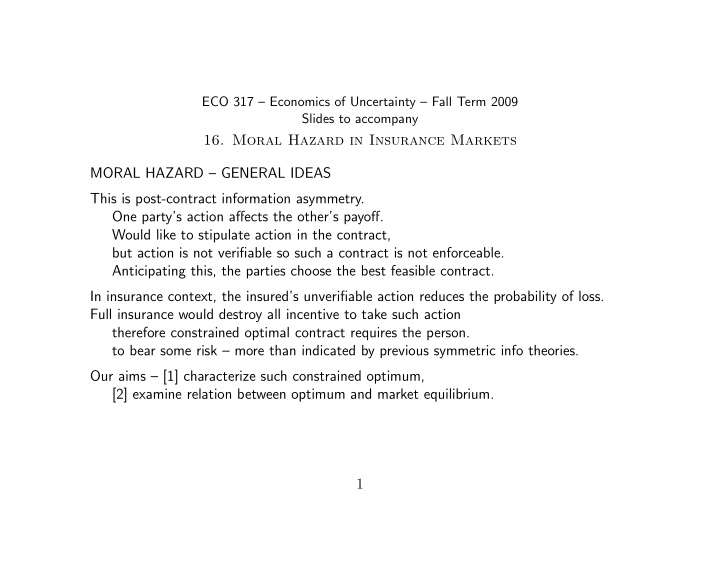



ECO 317 – Economics of Uncertainty – Fall Term 2009 Slides to accompany 16. Moral Hazard in Insurance Markets MORAL HAZARD – GENERAL IDEAS This is post-contract information asymmetry. One party’s action affects the other’s payoff. Would like to stipulate action in the contract, but action is not verifiable so such a contract is not enforceable. Anticipating this, the parties choose the best feasible contract. In insurance context, the insured’s unverifiable action reduces the probability of loss. Full insurance would destroy all incentive to take such action therefore constrained optimal contract requires the person. to bear some risk – more than indicated by previous symmetric info theories. Our aims – [1] characterize such constrained optimum, [2] examine relation between optimum and market equilibrium. 1
PERFECT INSURANCE – REMINDER From Lecture Note 9, pp. 1-4. Initial wealth W 0 , loss L in state 2; probability of loss π Can choose level of insurance; p = premium per dollar of coverage (indemnity) Budget line in state-contingent wealth space ( W 1 , W 2 ) : (1 − p ) W 1 + p W 2 = (1 − p ) W 0 + p ( W 0 − L ) Slope of budget line = (1 − p ) /p EU = (1 − π ) u ( W 1 ) + π u ( W 2 ) Slope of indiff. curve on 45-degree line = (1 − π ) /π . If statistically fair insurance is available in competitive market, then p = π ; tangency on 45-degree line, customer buys full coverage. 2
MORAL HAZARD WITH DISCRETE EFFORT CHOICE Person can choose whether to make effort to reduce risk of loss. Utility cost of effort is c , lowers probability from π b to π g If promised state-contingent wealth amounts ( W 1 , W 2 ) , person will make effort if (1 − π g ) u ( W 1 ) + π g u ( W 2 ) − c > (1 − π b ) u ( W 1 ) + π b u ( W 2 ) c < [ π b − π g ] [ u ( W 1 ) − u ( W 2 )] u ( W 1 ) − u ( W 2 ) > c / [ π b − π g ] In case of log utility, this becomes W 1 > W 2 exp { c / [ π b − π g ] } Region below the flatter line in figure. In particular – if full insurance ( 45 o line), then no effort. 3
This affects the person’s indifference curves EU = k . In the effort region, it is (1 − π g ) u ( W 1 ) + π g u ( W 2 ) − c , with MRS � − dW 2 = ∂EU/∂W 1 = 1 − π g u ′ ( W 1 ) � � dW 1 ∂EU/∂W 2 π g u ′ ( W 2 ) � EU = const � In the no-effort region, it is (1 − π b ) u ( W 1 ) + π b u ( W 2 ) , with MRS 1 − π b u ′ ( W 1 ) calculated similarly π b u ′ ( W 2 ) With π g < π b , we have (1 − π g ) /π g > (1 − π b ) /π b Therefore at the boundary, the indifference curve is steeper on the effort side. A firm offering to move the person from ( W 0 , W 0 − L ) to ( W 1 , W 2 ) has expected profit (1 − π g ) W 0 + π g ( W 0 − L ) − (1 − π g ) W 1 − π g W 2 in the effort region. Then its zero-profit line has slope (1 − π g ) /π g . Similarly in the no-effort region the zero-profit line has slope (1 − π b ) /π b ; flatter. 4
Figures show a typical indifference curve and a zero expected profit line. Observe the non-convexities in both. The insurance company wants to maximize expected profit E Π , but in competition must offer the consumer at least as much EU as he can get elsewhere. And competition reduces the company’s maximized expected profit to zero. The effect is equivalent to maximizing EU subject to E Π = 0 . 5
The two figures show two types of outcomes: c is small relative to π b − π g c is large relative to π b − π g Optimal underinsurance to give customer No-effort optimal; high loss probability π b just enough incentive to make effort. and full insurance at this price. So competition can achieve optimum constrained by moral hazard. But: Must prevent consumer buying multiple policies from different companies. Achieved by exclusivity requirement or every policy being secondary. 6
Recommend
More recommend